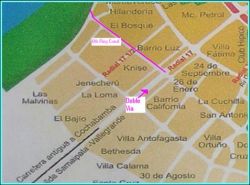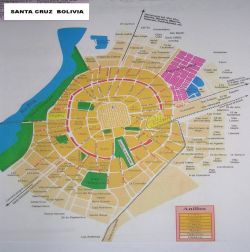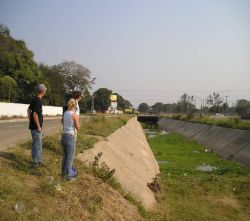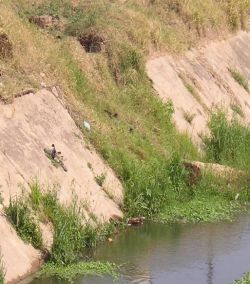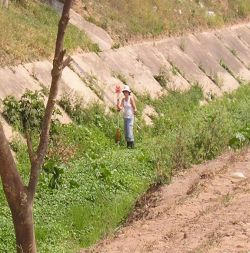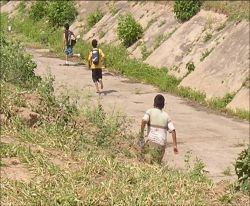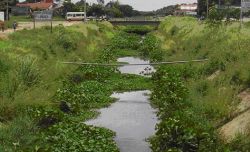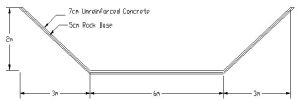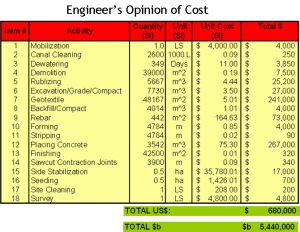
 |
Concrete
Storm Drainage Canal Rehabilitation El Sexto Anillo, Santa Cruz,
Bolivia EMT Eric
Krause International
Senior Design, CE 4990 & 4905 August 2005 |
Project Background In August, 2005, a group of Civil/Environmental Engineering students from Michigan Technological University traveled to Santa Cruz, Bolivia. The International Senior Design Class has been returning yearly since 2001 to the outskirts of Santa Cruz to continue solving Civil/Environmental engineering problems and providing local communities engineering design solutions to aid in their health and welfare.This group of 3 students, EMT Engineering, studied problems associated with a concrete storm water canal located on the southern outskirts of Santa Cruz. In the 1980s the City of Santa Cruz constructed the concrete-lined canal along el Sexto Anillo (the 6th Ring road). The canal extends from Doble Vía Santa Cruz- La Guardia (Road) to a natural river outlet, approximately 3,000 m (10,000 ft). The canal carries runoff from 6th Ring and the surrounding watershed. The City Engineers of Santa Cruz told EMT the designed slope was sufficient for the storm water to drain down the canal into the river. However, when the canal was built, the construction company did not survey to check the grade; instead they used a hose and running water. Consequently, the upstream portion is almost flat, but the downstream end of the canal has a sufficient grade of 0.5% (per EMT Engineering survey). Storm water pools at the east end due to this flat grade and creates more of a water garden than a drainage canal. The ponding portion of the canal is approximately 2,200m (7,200 ft) long. The stagnate water is not only an eyesore; it also gives off an unpleasant odor, and poses health and safety risks; including acting as a breeding ground for malaria-carrying mosquitoes. The city of Santa Cruz has asked EMT Engineering to produce a design recommendation to rehabilitate the canal and alleviate this problem. |
|
|
Existing Conditions Urban open channel
in a trapezoidal configuration. |
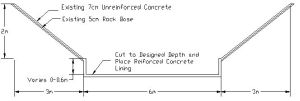 |
Option 1: Remove and Lower Canal Base Idea suggested
by the City Engineering Department of Santa Cruz. Ruled out?RISK
of structural failure due to undermining the base of existing canal |
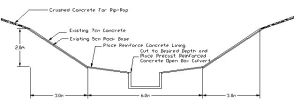 |
Option 2: Trapezoidal Channel with Pre-Cast Pilot Channel Salvages existing
sides Cost: $750,000-$900,000 US Ruled out ? RISK, COST, unfamiliar construction and cross-section.
|
|
|
Most Feasible--Option 3: Complete Reconstruction of 8,400 ft (2,600 m) of Canal Demolition of
8,400 ft (2,600 m) of existing canal : Cost: $680,000
US ($b 5.44 Million)
|
 |
|
|
Note: *Costs based on: Bolivian cost information, RS Means, duration
of project and construction experience. Decision Matrix Comparing Reconstruction with Maintaining Existing
|
Pros and Cons of Reconstruction Pros Recommendations The final recommendation of EMT is based on: Future development The City may also choose to forego this recommendation in lieu of seeking a more suitable, less expensive solution. If the City:
It is the recommendation of EMT that nothing be done at this time and the canal be re-evaluated and redesigned for future increased flow within the next 10-15 years. The proposed
reconstruction cross-section and gradient is based on current flows.
If none of the above is applicable, EMT recommends constructing
the proposed design, option 3. Since EMT believes the existing canal
will only be viable for 10 to 15 more years and the standing water
poses serious health and safety risks, complete reconstruction is
the only sustainable option investigated at this time.
|
| Michigan Technological
University Department of Civil and Environmental Engineering 1400 Townsend Drive Houghton, Michigan, 49931 - 1295, USA Department Phone: 1-906-487-2520 Department Fax: 1-906-487-2943 Department E-mail: cee@mtu.edu |
